But
humble bowls of pho and turmeric-tossed cha ca fish aren't the only culinary
draws in the capital of Vietnam.
An
influx of international restaurants, combined with a young population hungry
for a cosmopolitan lifestyle, has opened the door for a new generation of
Vietnamese cuisine.
Restaurants
and bars are catapulting traditional recipes into the 21st century -- and at
least one famous dish has been reimagined in cocktail form.
As
traditional Vietnamese food goes head-to-head with fashionable foreign fare,
it's never been a more exciting time to travel to this culinary wonderland.
From
pho cocktails to xoi ga (sticky rice with chicken), CNN Travel trawls the
capital to find the best of Hanoi's contemporary Vietnamese fare.
MAD Society
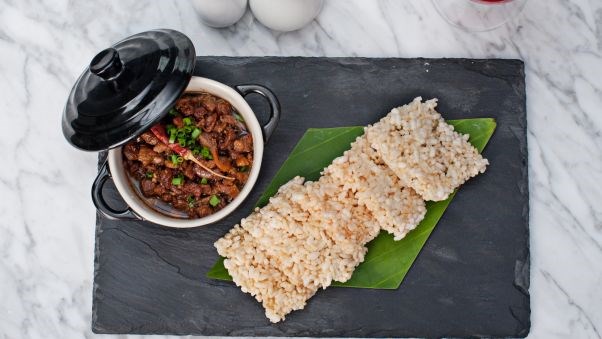
Not your average rice crackers. From MAD Society
Located
inside a new mixed-use complex in the ever-expanding Tay Ho (West Lake)
District, MAD Society has no qualms about playing with tradition.
"Vietnamese
food is amazing, but wherever you go, it's very similar," founder So Yeon
Kim tells CNN Travel.
"I
thought, let's try to have some fun and combine it with other Asian flavors. It
works so well!"
Taking
its cues from tapas-style dining, there are more than a dozen small dishes
which can be mixed and matched to create a meal.
"The
tapas idea came from noticing that more young Vietnamese want to pair food with
wine or spirits," explains So. "Pairing Asian flavors with wine works
perfectly, because both wine and many Asian ingredients are fermented."
“You can't survive these days
unless you adapt.”
So Yeon Kim, Mad Society
One
such dish is the edamame dip with shrimp chips -- popular in Vietnam and across
Southeast Asia -- with a hummus-like dip made from Japanese edamame beans.
Besides
tapas, the menu also includes a few reworked street food classics. For example,
pho comes in two styles.
The
first is relatively authentic, served with either beef, chicken or seafood but
not without theatrical flair, as the broth is poured from a floral Bat
Trang-style ceramic teapot.
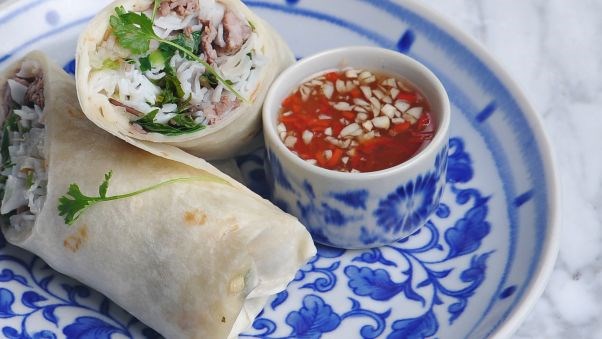
Ever had a phoritto? From MAD Society
The
second style? Hanoi's first phoritto.
Picture
beef, herbs, noodles and, yes, even a splash of broth -- all rolled up in a soft
tortilla.
In
a similar vein, MAD Society also serves cha ca-style tacos. The crispy tortilla
shells (in lieu of rice noodles) arrive loaded with traditional
turmeric-marinated fish and all the tasty herbs and vegetables.
"You
can't survive these days unless you adapt," says So. "You can keep
traditions, they're important -- but you need to have new things."
MAD Society, 4/F,
Somerset West Point, 2 Tay Ho, Tay Ho, Hanoi, Vietnam; +84 24 3200 6881
The T-Art

Contemporary digs at The T-Art. From The T-Art
Marred
by overpriced tourist traps and kitschy western restaurants, Hanoi's historic
Old Quarter doesn't always showcase the best of Vietnamese food.
But
the T-Art -- short for The Taste of Art -- opened in July and has already
chiseled out a reputation as the go-to place for modern Vietnamese cuisine.
Developed
by chef Duong Hai Anh -- who penned a book on modern Vietnamese appetizers
while working at the Hanoi Opera House's Nineteen 11 Restaurant & Bar --
the menu focuses on premium ingredients and modern presentations.
"I
want to bring Vietnamese food more in line with international cuisine,"
Duong tells CNN Travel.
"I
love the taste of traditional Vietnamese food, but I want to create and present
Vietnamese dishes in a more modern way."
Having
studied under a French chef at cooking school, Hai Anh embraced the art of
presentation early in her career -- and it's evident in her dishes.
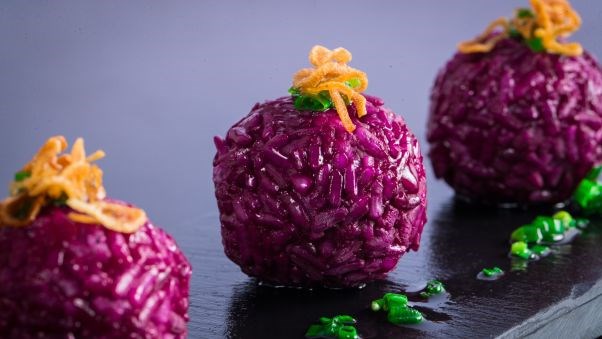
Xoi ga gets a makeover at The T-Art. From The T-Art
Take
the xoi ga, for example: Typically eaten out of a polystyrene tray, this local
dish is usually a mess of shredded chicken, crispy onions, spices and rice.
But
at The T-Art, the street dish transforms into three tidy balls of rice -- all
imbued with a vivid purple color, courtesy of magenta leaves (a native plant
used for food dye and medicine).
Presented
on an Instagram-friendly slate, each manicured ball is full of marinated
chicken, mushrooms and mung beans.
Hai
Anh has also taken aim at one of the most quintessential Hanoian dishes: cha
ca.
It's
usually served in a sizzling pan, where thin slices of turmeric-marinated fish
bubble in oil alongside fresh dill and green onions.
"In
the traditional style, the fish sits in oil too long," says Duong. "I
cut the fish thicker, and then marinade it longer. It's then grilled, so it's
less oily, and much more tender."
The T-Art, 46B Bat
Dan, Hoan Kiem, Hanoi, Vietnam; +84 24 3875 4646
Nê Cocktail Bar
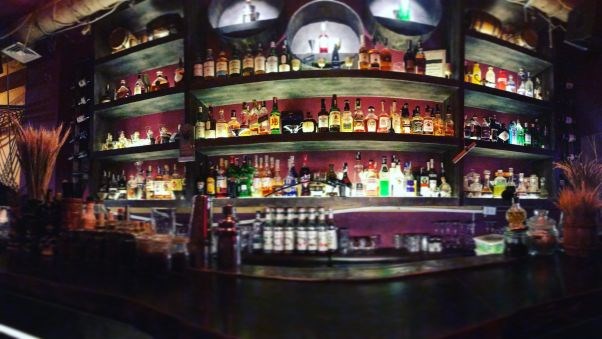
Inside Nê Cocktail Bar. From Nê Cocktail Bar
Hanoi's
restaurants aren't the only ones getting creative.
While
it might sound like something out of "Charlie and the Chocolate
Factory," you can now enjoy several Vietnamese dishes in the form of
artisan cocktails, thanks to master mixologist Pham Tien Tiep.
In
a career which has seen him rise from shining shoes on the street to
representing his country at international bartender competitions, Pham is now
the proud owner of Nê Cocktail Bar.
Named
after his son -- who is in turn named after Pham's favorite drink (a negroni)
-- Nê is a chilled-out space.
“I want people to experience my
drinks with all their senses.”
Pham Tien Tiep, Nê Cocktail Bar
There's
jazz instead of the usual thumping Vinahouse music, and craft cocktails instead
of 50 cent bia hoi (Vietnamese draft beer).
Now
emulated in bars across the city, Pham's most famous creation is the pho
cocktail.
"I
worked in a pho restaurant for a year, so I knew how to cook the real
dish," Pham tells CNN Travel.
"Before
the bartender competition in 2012, I thought: 'Why not try to make a drink with
the same flavor as pho?'"
To
craft the drink, Pham uses a custom-built apparatus with a three-tiered filter.
He
places star anise, cinnamon and cardamom into the filters, followed by a mix of
gin and Cointreau. Then he sets the mixture on fire as it runs through the
filters.
"The
fire cooks the cocktail, just like cooking the soup," says Pham.
"Then we add coriander, and serve with chili and lime, so it's like real
pho."
"I
want people to experience my drinks with all their senses."

Introducing: The pho cocktail. From Nê Cocktail Bar
Proving
he's more than a one-trick pony, Pham has since created a number of cocktails
based on Vietnamese cuisine.
The
Donna Donna cocktail -- inspired by bo luc lac (shaking beef) -- even requires
a bit of cooking.
Pham
first stir-fries beef with capsicum, chili and lemongrass, before de-glazing
the pan with rum and sugar. Then the resulting syrup is mixed with lime juice
to balance the flavor.
If
you're still standing after a few of those, we'd recommend The Pickles
cocktail, which channels traditional Vietnamese sour fish soup.
Before
you know it, you'll have sipped through a three-course Vietnamese dinner.
Nê Cocktail Bar, 3B
Tong Duy Tan, Hoan Kiem, Hanoi, Vietnam; +84 90 488 6266
Don's Bistro
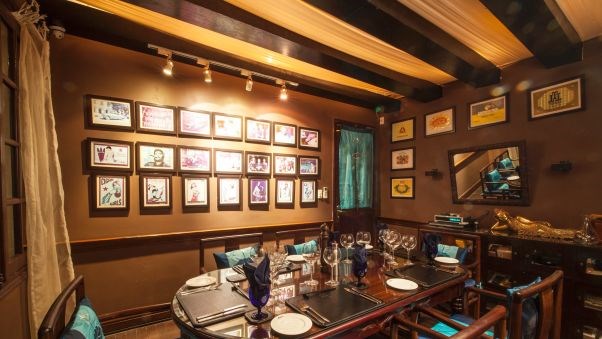
Inside Don's Bistro. From Don's Bistro
Overlooking
Tay Ho -- the largest lake in Hanoi -- Don's Bistro has become something of a
local landmark.
Since
opening in 2009 as the first Western restaurant on the lake, chef-owner Donald
Berger and his award-winning team have been at the forefront of Hanoi's
international food scene.
On
the menu, there are more than a dozen Vietnamese classics -- most of which have
been altered in some creative way.
Perhaps
the best example is Don's signature pho.
Enjoyed
any time of day, this rice noodle soup is traditionally always served with beef
or chicken.

Donald Duck Pho a l'Orange. From Don's Bistro
But
at Don's Bistro? The signature Donald Duck Pho a l'Orange comes with two forms
of duck: leg and breast.
The
leg is prepared confit-style, while the breast meat comes medium-rare as a nod
to the raw beef found in traditional pho.
Thick
slices of fresh orange add a bittersweet note and double as a colorful
centerpiece.
In
another unique twist on Vietnamese classics, Montreal-born Berger has imbued
traditional fresh spring rolls with a taste of fresh seafood and trendy avocado
from his Canadian homeland.
Instead
of the usual herbs, rice noodles, prawns and pork, Berger's spring rolls come
packed with crab, avocado and mayonnaise.
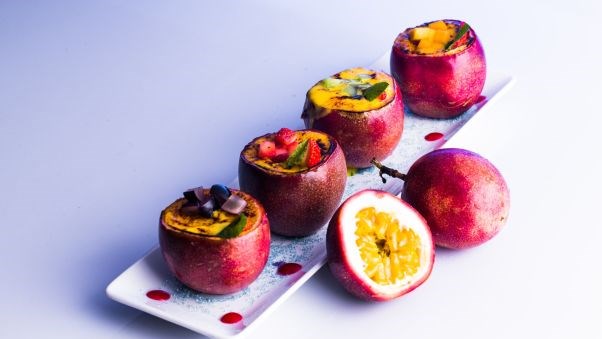
Passionfruit crème brûlée. From Don's Bistro
Each
roll is topped with colorful Masago, an Icelandic caviar, which not only
enhances the fresh, salty flavor but also adds a dash of sophistication.
"Presentation
is a big part of it, but you can have new flavors too." Berger tells CNN
Travel. "Sometimes being different is the same as being authentic."
The
creativity trickles down to the dessert menu, where diners will find a
passionfruit crème brûlée with tropical Vietnam written all over it.
"It's
lighter and more fragrant than a traditional crème brûlée," explains
Berger. "It's quite similar to che, a local soup-like dessert."
Don's Bistro, 16
Quang An, Tay Ho, Hanoi, Vietnam; +84 24 3719 3719
Green Tangerine
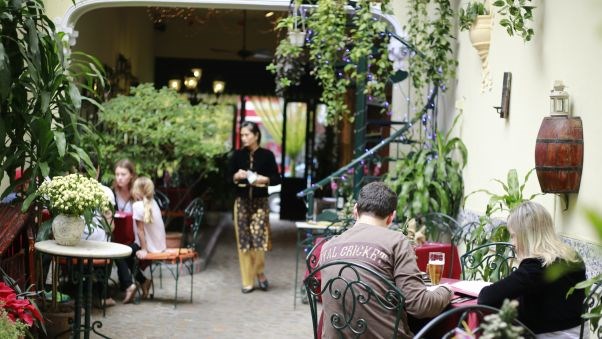
Al fresco feasts at Green Tangerine. From Green Tangerine
In
the center of Hanoi's crowded Old Quarter, there's a charming little oasis
serving up unique Vietnamese fusion dishes: Green Tangerine, set in a spacious
French colonial villa that dates back to 1928.
At
this al fresco address, the food is unmistakably French in technique but a
strong local influence pervades the flavors and ingredients.
"Vietnamese
flavors and French food are an ideal marriage," operations manager Nguyen
Dung tells CNN Travel. "I wouldn't call our food traditional -- it's
modern fusion, but still retaining an authentic Vietnamese taste."
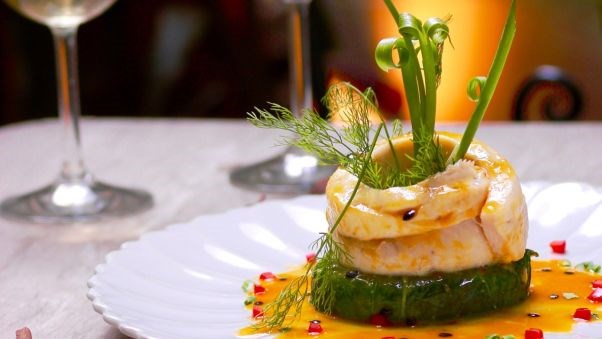
The ca qua risotto takes its cues from a Hanoian classic. From Green Tangerine
Ca
qua, or snakehead fish, is commonly used in Hanoi's cha ca dish
(turmeric-marinated fish with dill, scallions and rice noodles).
At
Green Tangerine, the ubiquitous ingredient appears atop a bed of risotto, which
has been wrapped in spinach leaves infused with ruou (Vietnamese rice liquor).
Then
there's the thit kho to, or Vietnamese caramelized pork -- a nod to the humble
dishes you'd find at canteens in schools and workplaces or at com binh dan rice
buffets.
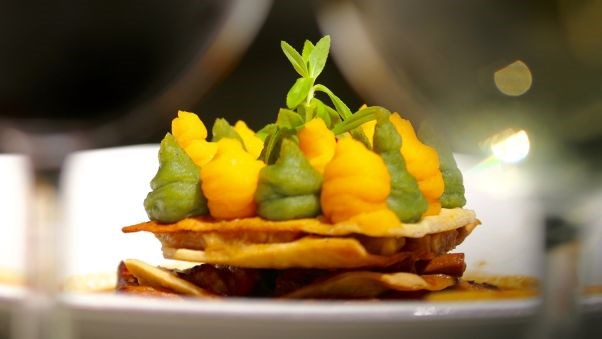
The French mille-feuille pastry gets a new look in Vietnam. From Green Tangerine
But
here, tender pork comes with stewed apples, local herbs, mashed carrot and taro
-- layered between crispy lotus seed sheets, inspired by flaky mille-feuille
French pastries.
For
chef Stephane Yvin, a former biological engineer, balance is the key.
"Stephane
uses the concept of yin and yang, combining Earth with the sea," explains
marketing manager Celia Tran. "It's about balancing flavors which work
best together."
The
red grouper tartare, in particular, is a colorful demonstration of this
philosophy.
Yvin
pairs raw ocean fish with local tropical fruits and rau tien vua, a leafy
vegetable known locally as the king's vegetable.
Green Tangerine, 48
Hang Be, Hoan Kiem, Hanoi, Vietnam; +84 24 3825 1286
Spices Garden
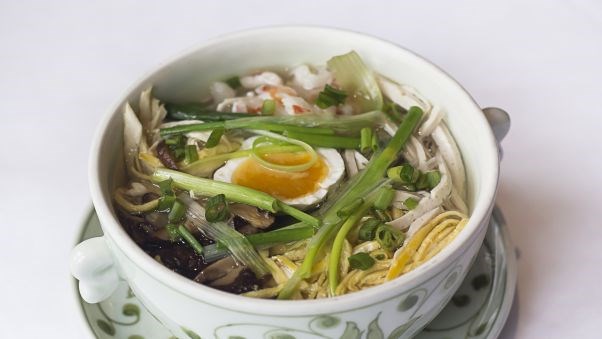
Fancy bun thang at Spices Garden. From Metropole Legend Hanoi Hotel
Set
inside the swish Sofitel Legend Metropole Hanoi hotel, Spices Garden has been
serving up upscale street food for more than 20 years.
In
the early days, menus were co-created by French chef and restaurateur Didier
Corlou.
Today,
the food is overseen by Hanoian chef Nguyen Thanh Van, who was the first
Vietnamese woman to become a member of l'Académie Culinaire de France back in
2007.
Like
any fine-dining restaurant worth its salt, Spices Garden offers a tasting menu
to enable diners to sample the signatures.
"Our
degustation menu is intended to give guests a taste of all three regions of
Vietnam," explains Nguyen.
"Abalone
soup, from the south; a tasting platter of Hanoian appetizers; and Nha Trang
lobster to represent the central region."
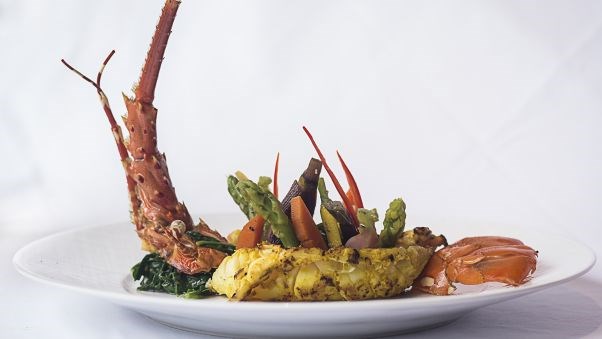
A taste of Nha Trang lobster. From Metropole Legend Hanoi Hotel
As
for the a la carte menu, diners can expect gourmet versions of traditional
dishes -- that means beautiful plating, high-quality ingredients and excellent
service.
But
the most exciting aspect of dining at Spices Garden is the professional
sommeliers, who can pair wine with anything from pho to spring rolls.
For
example, the black Angus beef tenderloin on the degustation menu is marinated
with lemongrass and local spices -- a combination that calls for a medium- to
full-bodied red.
"The
dish includes mushroom and chestnuts, which are quite wintery flavors, so I
would say a full-bodied red like a Cotes du Rhone," explains restaurant
manager Do Hong Long.
“It can compete with the best
French and Japanese food, for sure. Why not?”
Chef Nguyen Thanh Van, Spices
Garden
Other
well-known local dishes, such as cha ca, also benefit from a little French
wine.
"Cha
ca is the perfect dish to pair with wine -- fish sauce is quite a strong
flavor, so a light red, like a pinot noir, would be ideal," says Do.
Pairing
Vietnamese cuisine with wine is just one of the many ways that Vietnamese food
is starting to emerge from its low-budget street-eats niche.
"I'm
very confident in the reputation and development of our cuisine," says
Nguyen. "It can compete with the best French and Japanese food, for sure.
Why not?"
Spices Garden,
Sofitel Legend Metropole Hanoi, 15 Ngo Quyen, Hoan Kiem, Hanoi, Vietnam; +84 24
3826 6919
By CNN Travell